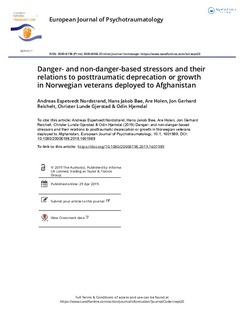| dc.contributor.author | Nordstrand, Andreas Espetvedt | |
| dc.contributor.author | Bøe, Hans Jakob | |
| dc.contributor.author | Holen, Are | |
| dc.contributor.author | Reichelt, Jon Gerhard | |
| dc.contributor.author | Gjerstad, Christer Lunde | |
| dc.contributor.author | Hjemdal, Odin | |
| dc.date.accessioned | 2019-05-02T06:53:19Z | |
| dc.date.available | 2019-05-02T06:53:19Z | |
| dc.date.created | 2019-04-30T10:47:15Z | |
| dc.date.issued | 2019 | |
| dc.identifier.issn | 2000-8066 | |
| dc.identifier.uri | http://hdl.handle.net/11250/2596220 | |
| dc.description.abstract | Objective: This study aimed to explore how exposure to danger-based and non-danger-based stressors may influence personal changes in veterans (N = 4053) after deployment to Afghanistan.
Method: Twelve war zone related traumatic events were used to form two stressor categories. The non-danger-based category included two stressor types: Moral Challenges and Witnessing, and the danger-based category included one type: Personal Threat. Thus, three stressor types were explored in relation to self-reported personal changes after war zone stressor exposure, e.g. negative changes labelled posttraumatic deprecation, positive changes labelled posttraumatic growth or no major change. Furthermore, the relationship between the stressor types and reported levels of distress were explored.
Results: The two non-danger-based stressor types, Moral Challenges (p < .001) and Witnessing (p < .001), were both significantly more associated with deprecation rather than growth, when compared to Personal Threat. Moreover, the non-danger-based stressors were significantly associated with a rise in posttraumatic stress symptoms, as well as a rise in symptoms of depression, anxiety and insomnia (p < .001). In contrast, exposure to the danger-based stressor was only significantly associated with a rise in the posttraumatic stress symptoms in the current model (p < .001). Reports of no-change were significantly associated with low degrees of exposure to all the three stressor types (p < .001).
Conclusion: The current study highlights the special adverse effects of non-danger-based stressors. Our findings show that they are more associated with posttraumatic deprecation rather than with growth. This underscores the heterogeneity of responses to traumatic events and adds to the current knowledge about the impact of various stressor types. | nb_NO |
| dc.language.iso | eng | nb_NO |
| dc.publisher | Taylor & Francis | nb_NO |
| dc.rights | Navngivelse-Ikkekommersiell 4.0 Internasjonal | * |
| dc.rights.uri | http://creativecommons.org/licenses/by-nc/4.0/deed.no | * |
| dc.title | Danger- and non-danger-based stressors and their relations to posttraumatic deprecation or growth in Norwegian veterans deployed to Afghanistan | nb_NO |
| dc.type | Journal article | nb_NO |
| dc.type | Peer reviewed | nb_NO |
| dc.description.version | publishedVersion | nb_NO |
| dc.source.volume | 10 | nb_NO |
| dc.source.journal | European Journal of Psychotraumatology | nb_NO |
| dc.source.issue | 1 | nb_NO |
| dc.identifier.doi | 10.1080/20008198.2019.1601989 | |
| dc.identifier.cristin | 1694696 | |
| dc.description.localcode | © 2019 The Author(s). Published by Informa UK Limited, trading as Taylor & Francis Group. This is an Open Access article distributed under the terms of the Creative Commons Attribution-NonCommercial License (http://creativecommons.org/licenses/by-nc/4.0/) | nb_NO |
| cristin.unitcode | 194,67,40,0 | |
| cristin.unitname | Institutt for psykologi | |
| cristin.ispublished | true | |
| cristin.fulltext | original | |
| cristin.qualitycode | 1 | |

